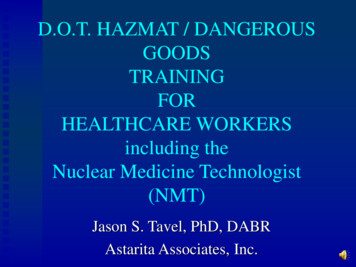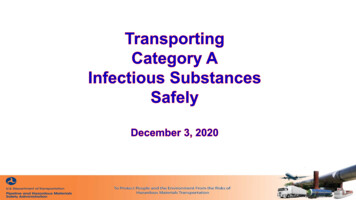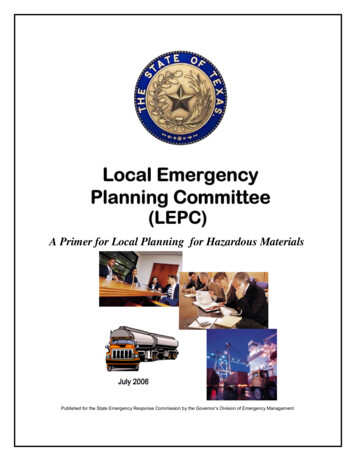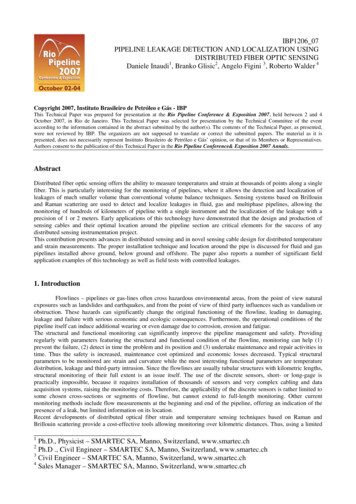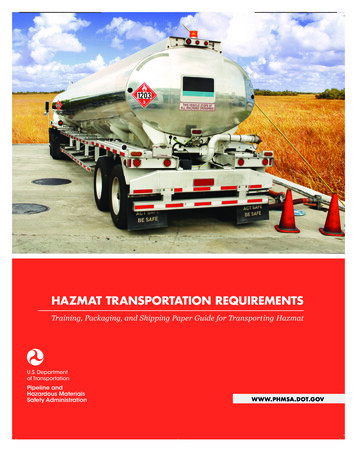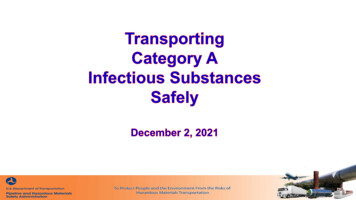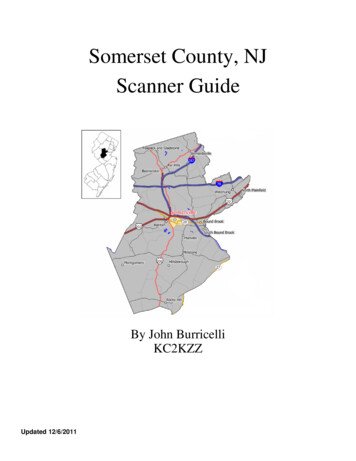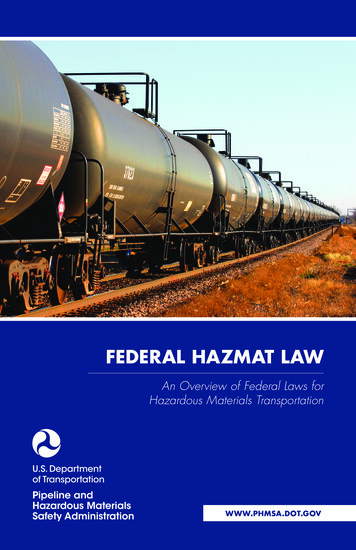
Transcription
FEDERAL HAZMAT LAWAn Overview of Federal Laws forHazardous Materials TransportationWWW.PHMSA.DOT.GOV1PHMSA FEDERAL HAZMAT LAW
TABLE OF CONTENTSFEDERAL HAZMAT LAW 2CONGRESSIONAL PURPOSE REGULATORY AUTHORITY HAZARDOUS MATERIALS REGULATIONS APPLICABILITY REGULATORY FUNCTIONS 4THE PIPELINE AND HAZARDOUS MATERIALS SAFETYADMINISTRATION (PHMSA) THE FEDERAL MOTOR CARRIER SAFETY ADMINISTRATION (FMCSA) THE FEDERAL RAILROAD ADMINISTRATION (FRA)THE FEDERAL AVIATION ADMINISTRATION (FAA) THE UNITED STATES COAST GUARD (USCG) ENFORCEMENT 6PHMSA FMCSA FRA FAA USCG ENHANCED ENFORCEMENT AND INVESTIGATIONAUTHORITY 7ENFORCEMENT SANCTIONS 7ADMINISTRATIVE ACTIONS NOTICE AND OPPORTUNITY FOR A HEARING CIVIL PENALTIES COMPLIANCE ORDERS CRIMINAL PENALTIES CIVIL ACTION IN FEDERAL COURT PREEMPTION 9WAIVER OF PREEMPTION PUBLIC SECTOR TRAINING AND PLANNING GRANTS 10SECURITY PLANS 11EMERGENCY RESPONSE 11INCIDENT REPORTING EMERGENCY RESPONSE PARTNERSHIPS
FEDERAL HAZMAT LAWThe Federal Hazardous Materials Transportation law (Federal Hazmatlaw), 49 U.S.C. § 5101 et seq., is the basic statute regulating hazardousmaterials transportation in the United States.CONGRESSIONAL PURPOSESection 5101 states that the purpose of the Federal hazmat law is to“protect against the risks to life, property, and the environment that areinherent in the transportation of hazardous material in intrastate, interstate,and foreign commerce.”REGULATORY AUTHORITYSection 5103 provides that the Secretary of Transportation shall: Designate material (including an explosive, radioactive material,infectious substance, flammable or combustible liquid, solid orgas, toxic, oxidizing or corrosive material, and compressed gas)or a group or class of material as hazardous when the Secretarydetermines that transporting the material in commerce in a particularamount and form may pose an unreasonable risk to health andsafety or property; and Issue regulations for the safe transportation, including security, ofhazardous material in intrastate, interstate, and foreign commerce.HAZARDOUS MATERIALS REGULATIONSThe Hazardous Materials Regulations (HMR), 49 CFR Parts 171-180, coverthe following areas: Registration (Part 171; see also Part 107, Subpart G); Hazardous Materials Classification (Parts 171 and 173); Hazard Communication (Part 172, Subparts A-G); Training and Security (Part 172, Subparts H and I); Packaging Requirements (Parts 173, 178, 179, and 180); and Operational Rules (Parts 171, 173, 174, 175, 176, and 177).2
APPLICABILITYThe HMR apply to the transportation of hazardous materials in interstate,intrastate, and foreign commerce by aircraft, railcar, vessel, and motorvehicle.Hazardous materials include: Those items identified in 49 CFR § 172.101, including any materialthat meets the definition of a hazardous material as defined in 49CFR Part 173 Subparts C, D, and I; Hazardous wastes and hazardous substances (as determined understatutes administered by and regulations issued by the EnvironmentalProtection Agency); and Marine pollutants.The HMR apply to persons who: Transport hazardous materials in commerce (common, contract, andprivate carriers); Offer hazardous materials for interstate, foreign, and intrastatetransportation in commerce (offerors, sometimes called shippers); Design, manufacture, fabricate, inspect, mark, maintain, recondition,repair, or test a package, container, or packaging component thatis represented, marked, certified, or sold as qualified for use intransporting hazardous materials in commerce; Prepare or accept hazardous materials for transportation incommerce; Are responsible for the safety of transporting hazardous materials incommerce; Certify compliance with any requirement under the Federal hazmatlaw; and Misrepresent whether he or she is engaged in any activity listedabove.PHMSA FEDERAL HAZMAT LAW3
REGULATORY FUNCTIONSTHE PIPELINE AND HAZARDOUS MATERIALS SAFETYADMINISTRATION (PHMSA)PHMSA issues the HMR. PHMSA also has issued procedural regulations,including provisions on registration and public sector training andplanning grants (49 CFR Parts 105, 106, 107, and 110).PHMSA’s regulatory functions include: Issuing rules and regulations governing the safe transportation ofhazardous materials; Issuing, renewing, modifying, and terminating special permits; Issuing, modifying, and terminating approvals for specific activities; Receiving, reviewing, and maintaining important records (e.g.,incident reports); and Making (or issuing) administrative determinations whether State,local, or Indian tribe requirements: are preempted by the Federal hazmat law, or may remain in effect, under a waiver of preemption. Representing DOT in international organizations and working toassure the compatibility of domestic regulations with the regulationsof bodies such as: International Maritime Organization (IMO), International Civil Aviation Organization (ICAO), United Nations Subcommittee of Experts on the Transport ofDangerous Goods and on the Globally Harmonized System ofClassification and Labelling of Chemicals; and International Atomic Energy Agency (IAEA).4
THE FEDERAL MOTOR CARRIER SAFETY ADMINISTRATION(FMCSA)FMCSA issues regulations concerning highway routing of hazardousmaterials, the hazardous materials endorsement for a commercial driver’slicense, highway hazardous material safety permits, and financialresponsibility requirements for motor carriers of hazardous materials.THE FEDERAL RAILROAD ADMINISTRATION (FRA)FRA’s Hazardous Materials Division administers a safety program thatoversees the movement of hazardous materials across the U.S. railtransportation system, including shipments transported to and frominternational organizations. FRA is responsible for enforcing federal railand hazardous materials safety laws and regulations by rail.THE FEDERAL AVIATION ADMINISTRATION (FAA)FAA issues regulations covering hazardous materials which are part ofthe required aircraft equipment. FAA also regulates the transportation ofradioactive materials on passenger-carrying aircraft when the materialis intended for use in, or incident to, research or medical diagnosis ortreatment.THE UNITED STATES COAST GUARD (USCG)USCG regulates the bulk transportation of hazardous materials that areloaded or carried on board a vessel without benefit of containers orlabels, and received and handled by the vessel without mark or count.USCG also regulates ships’ stores and supplies.PHMSA FEDERAL HAZMAT LAW5
ENFORCEMENTUnder delegations from the Secretary (49 CFR Part 1), enforcementauthority under the Federal hazmat law is shared by PHMSA, FMCSA,FRA, FAA, and USCG. Each of these agencies has authority to enforce theHMR against any person subject to the HMR, but each has a particularemphasis to its enforcement activities:PHMSAPHMSA enforces the shipment of hazardous materials and themanufacture, fabrication, marking, maintenance, reconditioning, repair, ortesting of multi-modal containers that are represented, marked, certified, orsold for use in the transportation of hazardous materials.FMCSAFMCSA enforces the transportation or shipment of hazardous materials byhighway, and the Federal Motor Carrier Safety Regulations (49 CFR Parts350-399), issued under various motor carrier safety acts codified at 49U.S.C. § 501 et seq., § 30101 et seq., § 30301 et seq., and § 31501 etseq.FRAThe Federal Railroad Administration (FRA) enforces the transportation orshipment of hazardous materials by railroad, and the safety regulations(49 CFR 200-268) issued under the Federal Rail Safety Act (49 U.S.C. §20101 et seq.).FAAFAA enforces the transportation or shipment of hazardous materials by air,and all regulations applicable to air carriers and shippers by air issuedunder the Federal Aviation Act (49 U.S.C. § 40101 et seq.).USCGUSCG enforces the transportation or shipment of hazardous materials bywater, and enforces its own regulations governing the bulk transportationof hazardous materials by vessel and ships’ stores and supplies, andregulations issued under other laws, such as the Federal Water PollutionControl Act (33 U.S.C. § 1251 et seq., response to discharges of oil intoUnited States waters) and the Comprehensive Environmental Response,Compensation and Liability Act (42 U.S.C. § 960 et seq., response to therelease of hazardous substances into the environment within the UnitedStates coastal zone, as the designated On-Scene Coordinator).6
ENHANCED ENFORCEMENT ANDINVESTIGATION AUTHORITYThe enhanced enforcement and investigation authority provided by 49U.S.C. § 5121 allows the Administrator, or the Administrator's designee,to issue or impose emergency restrictions, prohibitions, recalls, or outof-service orders without notice or an opportunity for a hearing, butonly to the extent necessary to abate the imminent hazard. (PHMSAcurrently is drafting a rulemaking to address this authority.) In addition,DOT personnel may open the outer packaging of a package believed tocontain hazardous material. If a package is believed to pose an imminenthazard, the package may be removed from transportation in commerce.ENFORCEMENT SANCTIONSThe Federal hazmat law provides the following enforcement sanctions:ADMINISTRATIVE ACTIONSThe Secretary may investigate, conduct tests, make reports, issuesubpoenas, conduct hearings, require the production of recordsand property, take depositions and conduct research, development,demonstration, and training activities. In addition, the Secretary mayinitiate the following types of actions:NOTICE AND OPPORTUNITY FOR A HEARINGDOT may find that a person has violated the Federal hazmat law, or aregulation, order, special permit, or approval issued under the Federalhazmat law, only after notice and an opportunity for a hearing.CIVIL PENALTIESFor knowingly violating regulations: A minimum penalty of 250 per violation, except training violationsare subject to a 450 minimum penalty; A maximum assessment of 50,000 per violation per day, except 100,000 if violation results in death, serious illness, or severe injuryto any person, or substantial destruction of property.PHMSA FEDERAL HAZMAT LAW7
COMPLIANCE ORDERSThe Secretary may issue an order requiring compliance with the Federalhazmat law, or an order, special permit, or approval issued under law.Penalty Assessment Criteria:1. Nature and circumstances of violation,2. Extent and gravity of violation,3. Degree of respondent’s culpability,4. Respondent’s history of prior violations,5. Respondent’s ability to pay,6. Effect of penalty on respondent’s ability to stay in business; and7. Such other matters as justice may require (especially correctiveactions).CRIMINAL PENALTIESFor willful or reckless violations: For an individual: up to 250,000 and five years imprisonment. For a corporation: up to 500,000 and five years imprisonment. Criminal penalty of up to 10 years imprisonment for willful violationresulting in the release of a hazardous material that results in deathor bodily injury. (49 U.S.C. § 5124).CIVIL ACTION IN FEDERAL COURTU.S. Attorney General may bring civil penalty action in U.S. District Court,which may result in an injunction, punitive damages, and assessmentof civil penalties considering the same penalty amounts and factors asprescribed in an administrative case. (49 U.S.C. § 5122).8
PREEMPTIONThe Federal hazmat law at 49 U.S.C. § 5125, and the HMR at 49 CFRPart 107 Subpart C provides that, unless authorized by another Federallaw, a requirement of a State, local, or Indian tribe is preempted if: Compliance with both (1) the State, local, or Indian tribe requirement,and (2) any requirement of the Federal hazmat law (or a regulationissued under the Federal hazmat law) is not possible; or The State, local, or Indian tribe requirement as applied or enforcedis an obstacle to accomplishing and carrying out the Federal hazmatlaw (or a regulation issued under it); or The State, local, or Indian tribe requirement concerns a coveredsubject, and is NOT “substantively the same” as any provision of, ora regulation under, the Federal hazmat law concerning that subject.Covered subjects are: Designation, description, and classification of hazardous materials; Packing, repacking, handling, labeling, marking, and placarding ofhazardous materials; Preparation, execution, and use of shipping documents pertaining tohazardous materials and requirements related to the number, content,and placement of such documents; Written notification, recording, and reporting of the unintentionalrelease in transportation of hazardous materials; and Designing, manufacturing, fabricating, marking, maintaining,reconditioning, repairing, or testing of a package or container whichis represented, marked, certified, or sold as qualified for use in thetransportation of hazardous materials.Section 5125(c) of 49 U.S.C. provides that, beginning two years afterissuance of Federal highway routing standards, State and Indian tribehighway routing designations, limitations, and requirements relatingto hazardous materials will be preempted unless they meet Federalprocedural and substantive requirements. FMCSA issues regulations andpreemption determinations on highway routing of hazardous materials.Note: “Substantively the same” means that the non-Federal requirement conforms in everysignificant respect to the Federal requirement. Editorial and other similar changes are permitted.PHMSA FEDERAL HAZMAT LAW9
WAIVER OF PREEMPTIONNotwithstanding the preemption of a State or local requirement, 49 U.S.C.§ 5125(e) provides that the DOT may waive preemption upon a showingby the jurisdiction that its requirement: Affords an equal or greater level of protection to the public as isafforded by the Federal requirement; and Does not unreasonably burden commerce.FMCSA has authority to issue preemption determinations and waiversof preemption concerning highway routing requirements. PHMSA hasauthority to issue preemption determinations and waivers of preemptionwith regard to all other requirements. There is a right to petition a U.S.Court of Appeals for review of a preemption determination or waiver ofpreemption.PUBLIC SECTOR TRAINING ANDPLANNING GRANTSPHMSA manages a reimbursable grant program to enhance existing Stateand local programs for planning and training for responding to hazardousmaterials incidents.This program, authorized by 49 U.S.C. § 5116: Enhances implementation of the Emergency Planning and CommunityRight-to-Know Act of 1986 (EPCRA); and Provides funds (75 percent pass-through to local governments) toStates and Indian tribes for planning and training for emergencyresponse to hazardous materials accidents and incidents.Under 49 U.S.C. § 5108, PHMSA funds the grant program withregistration fees collected from certain transporters and shippers ofhazardous materials in commerce.10
SECURITY PLANSThe Federal hazmat law mandates that the Secretary issue regulationsthat require employers to develop and implement plans to address securityrisks related to the transportation of hazardous materials in commerce. (49CFR, Subpart I). A security plan must be in writing and contain: An assessment of possible transportation security risks for shipmentsof hazardous materials listed in § 172.800, Appropriate measures to address the assessed risks, includingmeasures on (1) personnel security, (2) unauthorized access, and (3)en route security.EMERGENCY RESPONSEINCIDENT REPORTINGCarriers must report immediately by telephone certain more serioustransportation incidents (49 CFR § 171.15). For those and other less seriousincidents, a written report must be submitted to DOT (49 CFR § 171.16).The carrier must notify the USCG National Response Center (NRC),(800) 424-8802 or (202) 267-2675. The NRC contacts departmentalpersonnel and the National Transportation Safety Board (NTSB), if thesituation warrants (49 CFR § 171.16).Notice involving an infectious substance (etiologic agent) may be givento the Director, Centers for Disease Control (CDC) and Prevention, U.S.Public Health Service, Atlanta, GA, (800) 232-0124 (toll free), in place ofnotice to the NRC. The NRC is linked to CHEMTREC, a service operatedby the American Chemistry Council (ACC), which can provide detailedinformation on the nature and action of most chemicals transported in theUnited States.PHMSA FEDERAL HAZMAT LAW11
EMERGENCY RESPONSE PARTNERSHIPSDOT supports State and local emergency response. The Departmentencourages the growth of industry mutual assistance programs with localgovernment personnel responsible for emergency response.To enhance the effectiveness of emergency response along the border,PHMSA and sister agencies in Canada and Mexico periodically issuea Emergency Response Guidebook (ERG) in three languages (English,French, and Spanish). The ERG cross-references commodities listed in theHazardous Materials Table by proper shipping name and by identificationnumber. The guidebook contains specific guides which: Alert first responders to potential dangers arising from the threat offire, explosion, or health hazards; and Recommend initial emergency actions regarding evacuationisolation of the affected area, firefighting, leaking containers, spillcontainment, and first aid.The success of the ERG is dependent on shipper and carrier compliancewith all hazard communication requirements (i.e., shipping papers, labels,marking, placards, and emergency response information). DOT hasdistributed over ten million copies of the ERG to first responders such asfirefighters and police.The ACC in collaboration with DOT has developed several programswhich address emergency response:1. Emergency response training through emergency response teamworkshops;2. A first responder training program; and3. CHEMNET, a mutual aid network of shippers and for-hire contractorsproviding direct on-site assistance during chemical emergencies.DOT has also funded demonstration projects in various communitiesdesigned to increase State and local involvement in planning andmanaging hazardous materials emergency preparedness programs.12
FOR ADDITIONAL INFORMATION CONTACT:The Hazardous Materials Info Center1-800-HMR-4922(1-800-467-4922)Email: infocntr@dot.govhttps://phmsa.dot.govOutreach, Engagement, and Grants Division1200 New Jersey Ave., SEWashington, DC 20590Email: training@dot.gov202-366-4900202-366-7342 (Fax)14
FRA's Hazardous Materials Division administers a safety program that oversees the movement of hazardous materials across the U.S. rail transportation system, including shipments transported to and from international organizations. FRA is responsible for enforcing federal rail and hazardous materials safety laws and regulations by rail.
